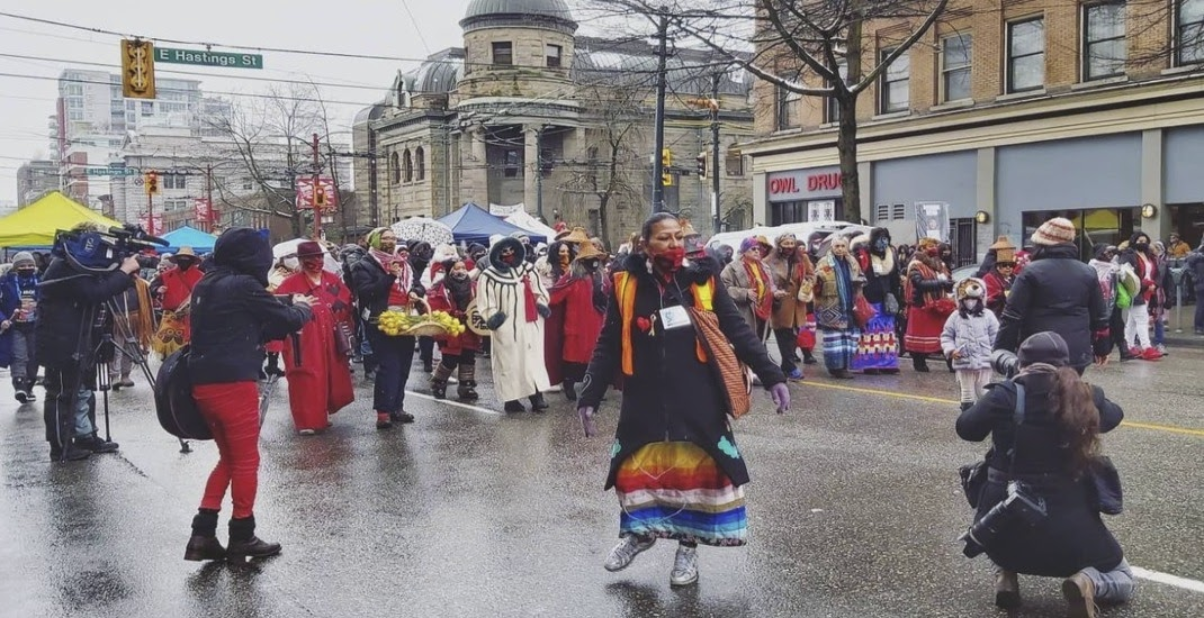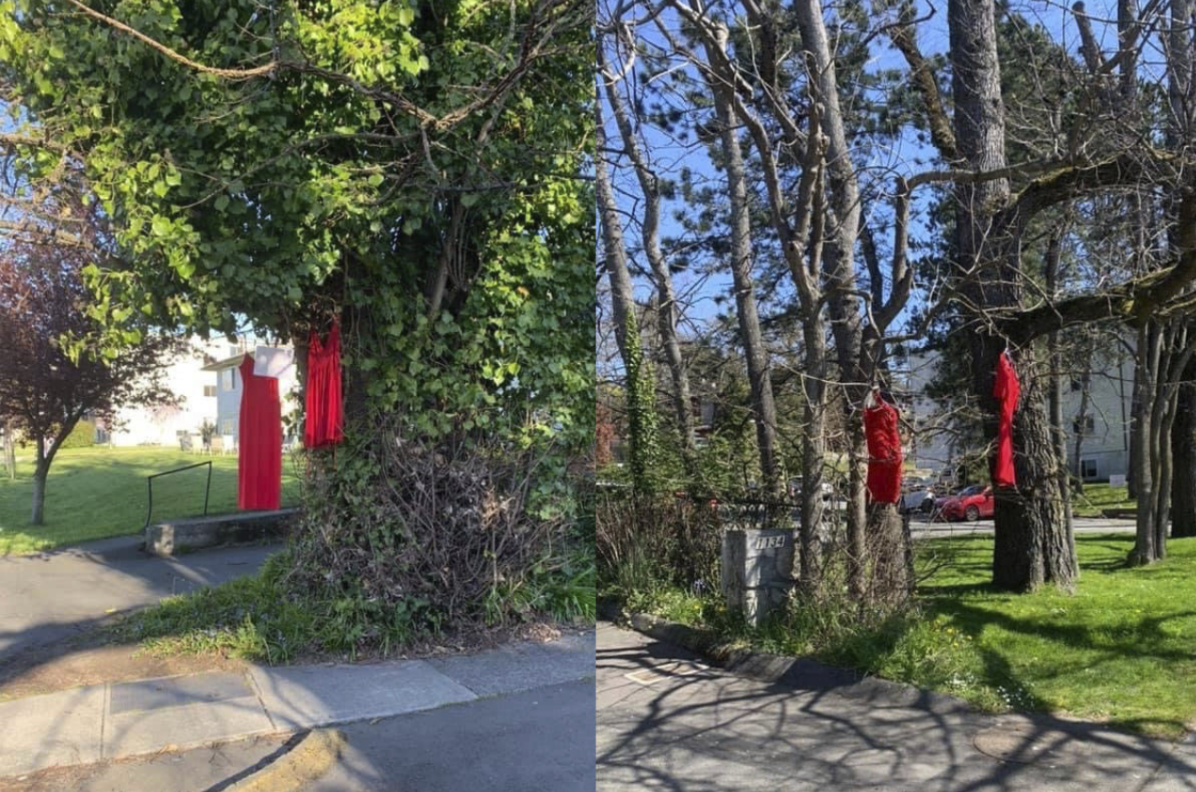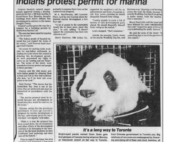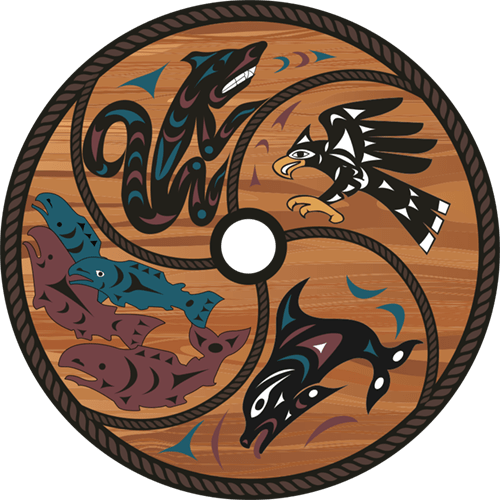In Canada, Indigenous women and girls are targeted for violence more than any other group.
They are 12 times more likely to go missing or be killed. In the US, they face murder rates up to 10 times higher than the national average.

An annual women’s memorial march to commemorate missing and murdered indigenous women and girls takes place each Valentines Day downtown Vancouver (image courtesy of Daily Hive)
In 2019, a national inquiry named this crisis in Canada a genocide. The in-depth report found that regularly, missing indigenous women and girls are stereotyped or stigmatized and their family’s concerns are dismissed. More often than not, police and justice systems are biased towards the perpetrators of murder, kidnapping and worse.
Two years later, the Prime Minister’s lack of meaningful action to address the 231 calls for justice continues to endanger the lives of indigenous women and girls. Since then, approximately another 200 indigenous women and girls have gone missing.
In Canada alone, there have been approximately 4,000 or more Indigenous murdered or missing women and girls in the last 30 years. That works out to about 133 a year, or three a week.
As Brandi Morin, an indigenous reporter and survivor of sexualized violence shares, this has been happening in Canada for far longer than the last 30 years. “White male colonizers raped Native women at epidemic rates and justified their actions because Indigenous peoples were labelled savages and less than human.” This legacy of colonial brutality continues to impede justice for missing and murdered indigenous women and girls and indigenous 2SLGBTQQIA+ community members.
An essay and poem by a young W̱SÁNEĆ student, Stephanie Joseph best illustrates the impact of this crisis.
“My name is Stephanie
No not the one standing in front of you
The one that was brutally murdered
I would’ve been forty two today
I would’ve woken up that day like any other
Have my warm feet touch the cold wooden floor, stretch my arms out in yawn
Like I always did
I would’ve seen my little girl grow up into the amazing woman I always knew she’d be
I would’ve had another child
I would’ve graduated
I would’ve walked down the aisle, Wearing the most beautiful white dress
When I put myself into routine, I thought nothing bad would ever happen but that’s not the case with me
One moment I’m sleeping the next I’m fighting for my life I’ve had so much ahead of me
But it was taken
My name is Stephanie, the one that was brutally murdered I would’ve woken up that day like any other.
The point of my speech is to make you uncomfortable, to think of yourself in my position; put you in the shoes that I have to walk in every single day because I have to live with the constant wonder of “am I next?” “ will my sister make it home okay?” “will the police do something if I or my sister go missing?” can you imagine having to worry the entire day that you have a target on your back at all times; having to spend your life looking over your shoulder at all times
Because of my tan skin, my cheekbones, my dark thick hair, my braids or the fact that my ethnicity seems to be arousing to sick perverted men.
Tell me, how would you feel if you knew your chances of going missing, being found murdered, harassed, violated or robbed of your innosense were higher than the people that surrounded you or if your death meant nothing to the officers that swore to serve you.
It’s frowned upon to hitchhike in northern BC But that doesn’t stop you
The man with the kind eyes
“Good intentions”
Who also happens to linger up and down this highway everyday
Wants to give you a ride
Easily persuaded by his genial words and affable smile
It’s hard to see the lies dripping from his mouth and it’s like the daggers he’s staring into you aren’t even there
All I wanted was to see my family
If they had known what would happen, would their decisions be different?
It’s not like i had much of a choice
There’s a reason they call it the highway of tears
I can’t give you pie charts, line graphs and big numbers because there is none, after all the time I had to study for my presentation I came up with nothing. I know there are many news articles and the report came out june third of 2019 but even the statistics stated the articles and statistics Canada, are deeply flawed due to the lack of deliberation put into these investigations, for instance, there was a statistic claiming that indigenous men killed 70% of murdered indigenous women, this number was cited by white nationalist Faith Goldie and journalist Jonathan Kay. These numbers were brought from carelessly collected data by the RCMP over the years. How can we trust these claims when there is no published research and they don’t want to share their sources? This kind of behavior and opinion persuades clueless onlookers into believing facts that are not true in any way shape or form. The 70% figure fails to mention the cases that were said to be “not suspicious”, unsolved cases and the cases that weren’t labeled as homicides.
This also fails to mention the cases that went unrecorded, the women and girls that didn’t have status cards or weren’t considered indigenous and the families that didn’t come forward.
If I were to be here today
If I were to come home earlier
If I had just listened to my grandmother
If I had felt her prayers and quit ignoring them If I had never met my killer
If I had survived
There was so much that could’ve been done This could’ve been prevented
A void that will never be filled
My family has to live with that fact
He is a free man and he still walks to this day
It is very clear that indigenous women and families don’t trust this system. It has been stressed by my people that this is genocide. How many more women and girls have to go missing? How much longer will it take? Before people realize that this is a large and very real problem in Canada and it’s been swept under the rug for too long.
I didn’t come here to give you facts or stick numbers in your face.
I came here to tell you as a girl, named after an amazing woman,
Whom I have never had the pleasure of knowing but hold in my heart dearly.
No daughter, no sister, no niece or mothers should become just another statistic.
No one should be robbed of their future.
My speech is supposed to make you uncomfortable
So I hope it did ”
Red dresses removed on Vancouver Island.
Despite the severity of the ongoing situation, lack of awareness, compassion and meaningful action still characterize the plight of so many indigenous families for whom their sisters, aunts, mothers, daughters and grandmothers are still missing.
Red dresses hanging in Esquimalt trees call attention to missing and murdered Indigenous women and girls (Photo by Normagene Thompson)
LLast year’s removal of the symbolic red dresses along the Island Highway by Oyster Bay and again in Esquimalt last year illustrates the need for continued awareness, allyship and action. The red dress project was inspired by the work of Metis artist Jaime Black who, in 2010 put up installations of red dresses in Manitoba to represent Indigenous women and girls lost to violent crimes.
In response, the Mayor of Saanich issued a letter of support to The W̱SÁNEĆ Leadership Council advising they’ve proclaimed May 5th as Red Dress Day.
The Mayor and stating their unequivocal support for any and all actions to combat the acts of racism recently experienced by First Nations people: “Council is committed to initiatives that support Missing and Murdered Indigenous Women and Children such as Red Dress Day on May 5th and is very interested in supporting actions surrounding Red Dress Day.”
“When we talk about this issue, it is so critical that we take the time to keep the memories of those we lost alive, and voices of survivors and families at the forefront. That is why days of awareness, remembrance, and action are important. We cannot forget about these injustices and that we all have a role to play in bringing an end to this ongoing tragedy.” shares Assembly of First Nations Alberta Regional Chief Marlene Poitras.
The W̱SÁNEĆ Leadership Council is honoured to share the work of Stephanie Young, to continue to spread awareness of this crisis, and to urge the Prime Minister to make good on his word to implement the 231 calls for justice.
For more information on the 231 calls for justice in Canada, visit this website.
RECENT POSTS
How are we doing?
“What she did was knit so we could eat. There were 12 of us and there needed to be a way to supplement my dad’s income. He was a fisherman and logger but the wages weren’t that good. With his work, he paid the bills. With her work, she made the meals. All of her knitting was to put food on the table.” Carl Olsen, remembering his late mother







